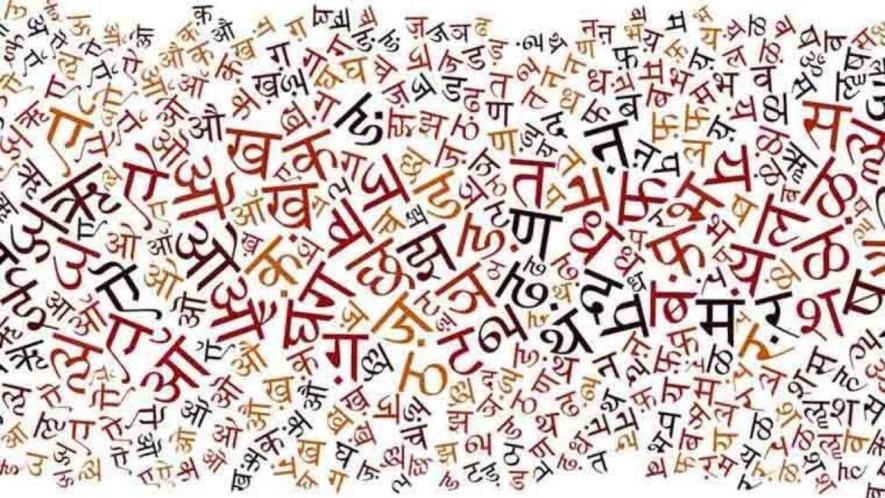Political Economy of Hindi Imposition in India

File Image
The National Education Policy (NEP) 2020 is a policy exercise to further privatisation, commercialisation, and gentrification of education. Consent for the exercise is sought to be manufactured by the saffronisation of education. A key prong of this process of manufacturing consent is Hindi imposition throughout India.
NEP 2020 has ostensibly involved a shift from Hindi being an obligatory linguistic component of the three-language formula that currently prevails in all states of India, except Tamil Nadu, to one whereby the three-language formula now included only the obligation to use two Indian languages (mother tongue and any other Indian language).
The approach of NEP 2020, while ostensibly promoting multilingualism, reveals a pattern of indirect mechanisms to impose Hindi. Two examples from Maharashtra and Tamil Nadu illustrate these ongoing indirect attempts to indirectly impose Hindi.
Contours of Hindi Imposition in Maharashtra
The Bharatiya Janata Party-led Maharashtra government’s April 2025 decision to make Hindi compulsory for classes 1–5 laid bare the neo-fascist dispensation's actual intent. This decision was made bypassing the state’s Language Advisory Committee, which criticised it as “educationally unsound” and contrary to scientific principles of child psychology. The committee’s chairperson, Lakshmikant Deshmukh, underlined that introducing Hindi from Class 1 would place undue burden on students.
Opposition parties in the state, including the Maharashtra Congress, opposed this imposition of Hindi. Faced with broad-based opposition, the BJP-led Maharashtra government backtracked. However, this reversal does not signify a retreat but a tactical recalibration. By retaining the three-language formula with purported flexibility, the BJP-led Maharashtra government maintains the structural conditions for Hindi imposition.
Maharashtra’s Chief Minister Devendra Fadnavis pointed out that language teachers for Indian languages other than Hindi are relatively scarce. This relative scarcity is due to years of imposing Hindi and devaluing other Indian languages through policy levers. In this deliberately created context of asymmetry, many schools are compelled to adopt Hindi.
Moreover, instituting a class to teach an alternative Indian language requires a minimum of 20 students per class—a threshold many institutions cannot readily meet without policy support. Private schools could argue that the third-language choice of an Indian language, other than Hindi, would require more expensive salaries for the teachers concerned, resulting in concomitant fee hikes. In such circumstances, Hindi imposition would transpire through policy facilitation masquerading as the purportedly voluntary choice of students and parents who are rationally seeking to minimise the cost of education.
The proposal to use “virtual modes” for teaching non-Hindi Indian languages risks relegating them to a secondary status, devoid of the living pedagogical immersion that classroom teaching alone can comprehensively provide.
Challenges Confronting TN’s Two-Language Formula
Tamil Nadu is a state that has strenuously opposed Hindi imposition. For decades, the two-language formula has prevailed in the state, where Tamil and English are taught to students.
All elements in Tamil society, except those connected to the neo-fascist dispensation, have upheld the two-language formula. Why has Tamil society opposed Hindi as a third language? Some arguments supporting this stance include the following:
- One, all Indian languages are equal in all social domains, and Hindi enjoys no privileged status.
- Two, the two-language formula is premised on Tamil being the mother tongue of the people and English remaining the principal (but not exclusive) repository of science and technology.
- Three, students are free to learn any other language, but no third language is obligatory.
- Four, advocates of the two-language formula have pointed out that in the (so-called) Hindi-speaking states, the three-language formula effectively entails Hindi, English, and Sanskrit, completely excluding all other Indian languages.
Union governments have never reconciled themselves to Tamil Nadu’s two-language formula and have tried to impose Hindi in the state, directly and indirectly. However, the neo-fascist dispensation has intensified efforts to impose Hindi, with the latest attempt involving the withholding of funds under the Samagra Shiksha Abhiyan unless the three-language formula is adopted. This aggressive Hindi imposition marks a concerning break from past practices of Union governments. But the resistance to Hindi imposition remains strong in Tamil Nadu.
Why Hindi Imposition?
Attempts to impose Hindi involve the ruling classes’ effort to solidify their hegemony by buttressing the myth of the unitary origins and destiny of Indian civilisation.
The myth of Indian civilisation’s unitary origins, centred around Sanskrit, is unscientific and contradicted by historical evidence from rigorous scholarship. Sanskrit, uncritically lauded in NEP 2020, is also facetiously posited by the neo-fascist dispensation as the sole progenitor of Hindi. Thereby, Hindi imposition is insidiously seen by the neo-fascist dispensation as either the second coming of Sanskrit or the stepping stone to that second coming.
Additionally, proponents of the neo-fascist dispensation, like ruling-class counterparts elsewhere (e.g., promoters of the mythical Western civilisation), conflate antiquity with primacy. This unscientific myth about Indian civilisation’s unitary origins serves as a premise to construct another myth: the unitary destiny of India as envisioned by the neo-fascist dispensation (Hindu Rashtra). This vision contradicts India’s Constitution and acts as an ideological veil for compromising India’s sovereignty to metropolitan capital.
The Union government’s persistent efforts to impose Hindi have a history inconsistent with the Constitution of India’s letter and spirit.
Hindi imposition emerged as the ruling classes’ preferred linguistic instrument by:
- One, destroying Hindustani, the syncretic ancestor of Hindi and Urdu, through communalisation promoted by British colonialism, while falsely claiming Urdu was a foreign language.
- Two, positing Devanagari alone as indigenous to (North) India, excluding Nastaliq and Kaithi scripts.
- Three, relegating North Indian languages like Rajasthani, Haryanavi, Braj Bhasha, Awadhi, Bhojpuri, Garhwali, Kumaoni, Angika, Bundeli, Chattisgarhi and many others to dialects of Hindi. Hindi also displaced Arunachal Pradesh’s indigenous languages. Attempts to declare Punjabi and Maithili as dialects of Hindi were defeated by popular opposition.
- Four, the parties of Indian monopoly capital were opposed to the formation of linguistic states.
Diversity and Democratic Resistance
The Constitution envisaged India as a ‘union of states’ with the motto “unity in diversity.” This dialectically implied that India’s unity requires cultivating its diversity and that promoting diversity is necessary to preserve India's unity.
Our Constitution is a product of the anti-colonial struggle, which historian Irfan Habib characterised as the Indian people’s greatest historical achievement. Arguably, the Constitution itself is their second-greatest achievement.
India’s ruling classes, given their incomplete opposition to metropolitan capital and propensity to compromise with its contemporary dominant segment (international finance capital), seek to solidify their hegemony by mostly perpetuating the myth of Indian civilisation’s unitary origins and destiny. They avoid grounding Indian nationhood in the anti-imperialism that informed the anti-colonial struggle and remains foundational to authentic democratic progress by resisting the neoliberal project. This avoidance is understandable since it is inconsistent with their hegemony.
The centring of anti-imperialism by a democratic resistance also sharply distinguishes it from the pitch of cosmopolitan neoliberals who deviously claim that incorporation into the ambit of metropolitan capital in a subordinate status is the optimal path to achieve freedom and democracy. Both the neo-fascists and the cosmopolitan neoliberals advocate compromise with metropolitan capital though their lexicon diverges.
Therefore, contemporary opposition to Hindi imposition has to be necessarily integrated with the resistance to the neoliberal project. Linguistic diversity is a necessary component of democratic resistance to the neoliberal project and its domestic champion, the neo-fascist dispensation.
C Saratchand is Professor, Department of Economics, Satyawati College, University of Delhi. The views are personal.
Get the latest reports & analysis with people's perspective on Protests, movements & deep analytical videos, discussions of the current affairs in your Telegram app. Subscribe to NewsClick's Telegram channel & get Real-Time updates on stories, as they get published on our website.
























